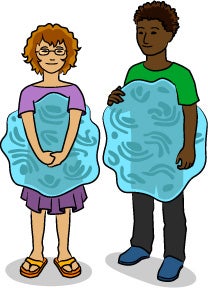The Story Behind the Scenes
In the Viral Attack comic, the body's fight against invaders was a success, thanks to the important work of key immune cells. But what more do we know about how these cells work as they fight off an attack from harmful viruses? That's what the "behind the scenes" section is all about.
As you click through the comic, the information buttons will take you directly to more in-depth information on the different cells you see. But you can also click on the links below to take you to a full page about each of these players in the story.
The Cells that are Part of the Immune System
 |
Epithelial cells Epithelial cells are one of the body's first lines of defense against invaders. These cells make up your skin, including the inside of other areas, like your mouth. But sometimes viruses sneak past these barriers. |
 |
Macrophages |
 |
Neutrophils Neutrophils are short-lived cells that arrive to the scene of the infection very early, alongside macrophages. They have many weapons to fight off invaders, but some of those also harm the body's other cells. Neutrophils also alert many other cells that more help is needed. |
 |
T-cells Two types of T-cells are very important to fighting infection. Helper T-cells coordinate the attack on invaders, and Killer T-cells destroy infected cells, helping to stop the spread. |
 |
B-cells B-cells play a very important role in immune defense. When you fight a specific virus, they are responsible for making antibodies. That helps you fight off the viruses in a targeted way, finishing the fight. |
 |
Memory cells T and B-cells are also important as memory cells. Memory cells live on after the battle and help your body remember those specific invaders. That way, you can fight them off faster if they appear again. |
Bibliographic details:
- Article: The Story Behind the Scenes
- Author(s): Dr. Biology
- Publisher: Arizona State University School of Life Sciences Ask A Biologist
- Site name: ASU - Ask A Biologist
- Date published:
- Date accessed:
- Link: https://askabiologist.asu.edu/viral-attack-behind-scenes
APA Style
Dr. Biology. (). The Story Behind the Scenes. ASU - Ask A Biologist. Retrieved from https://askabiologist.asu.edu/viral-attack-behind-scenes
Chicago Manual of Style
Dr. Biology. "The Story Behind the Scenes". ASU - Ask A Biologist. . https://askabiologist.asu.edu/viral-attack-behind-scenes
Dr. Biology. "The Story Behind the Scenes". ASU - Ask A Biologist. . ASU - Ask A Biologist, Web. https://askabiologist.asu.edu/viral-attack-behind-scenes
MLA 2017 Style
Be Part of
Ask A Biologist
By volunteering, or simply sending us feedback on the site. Scientists, teachers, writers, illustrators, and translators are all important to the program. If you are interested in helping with the website we have a Volunteers page to get the process started.


